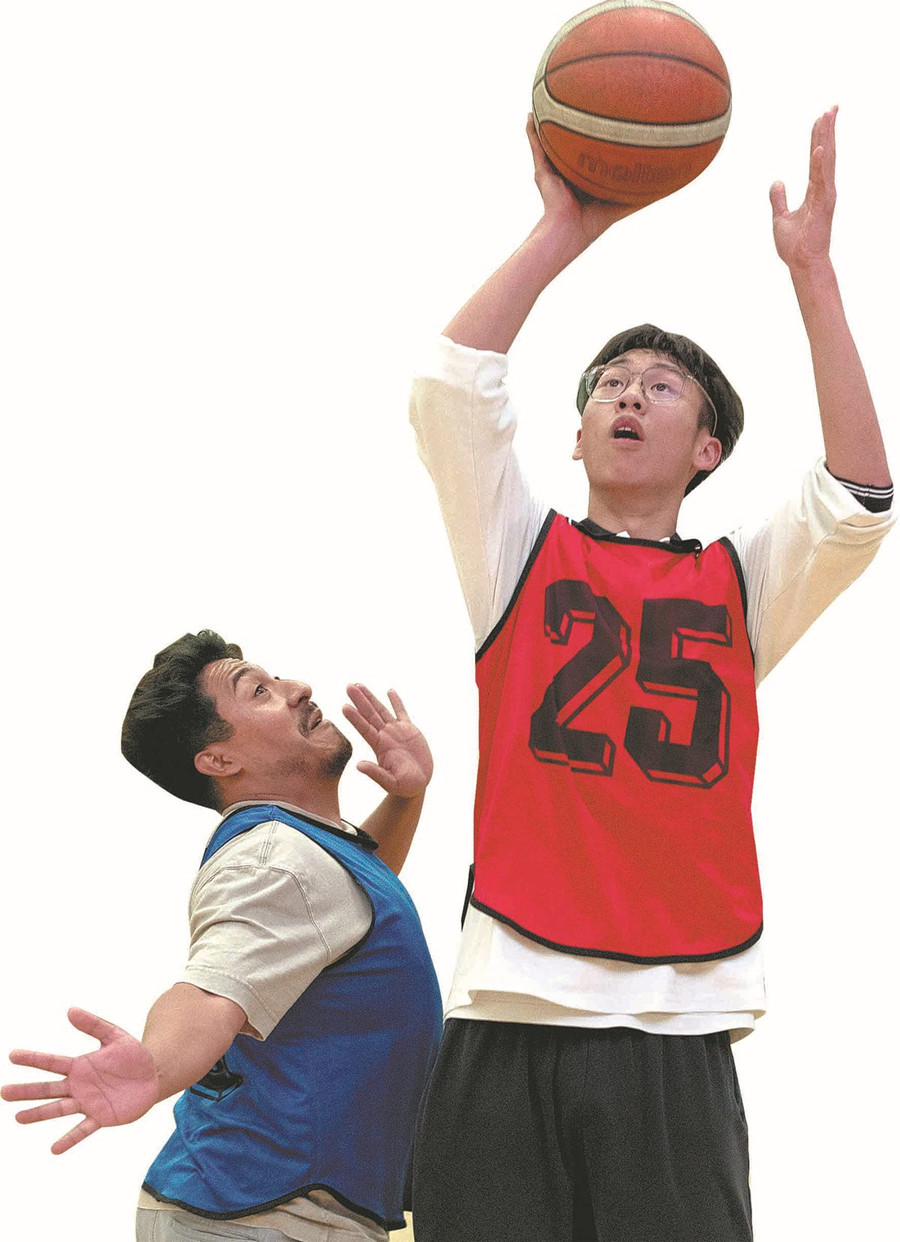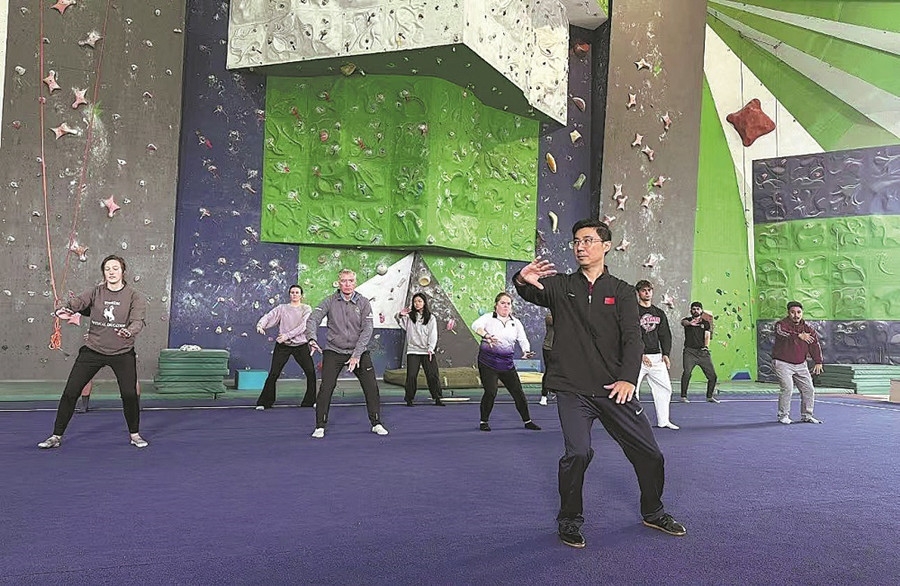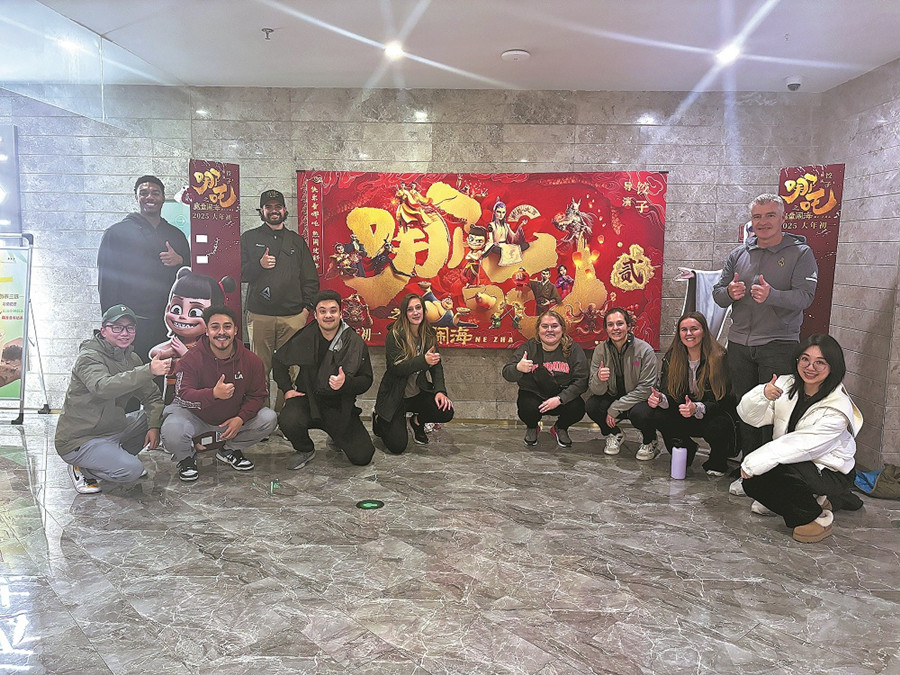Students sport a willingness to learn

James Paterson, a 26-year-old postgraduate student studying physical education at the University of Wyoming in the United States, recently got to check something off his bucket list with a monthlong "best-ever experience" in China, joining a physical education exchange program at the Shanghai University of Sport.
As a member of the UW's delegation under the American Short-Term Study in China Initiative, launched by the two universities three years ago, Paterson made the journey to China and spent the whole of March in Shanghai, where he collected knowledge, inspiration, cultural and living experiences, as well as forged new friendships.
"I am very fortunate, as it has been one of my dreams to come here and do what I love, which is physical education," he said.
"During our time in China, we have not only expanded our academic knowledge, but have also gained something even more valuable — perspective.
"We have seen firsthand that physical education and physical activity are universal languages.
"Though we may come from different cultures and speak different languages, our shared passion for movement and education has been a bridge that connected us all," said Paterson, describing the visit as one of the best experiences of his life.
Consisting of seven postgraduate students and two teachers, the Wyoming delegation stayed in Shanghai for four weeks. With a focus on sports education, they joined the SUS faculty and students to explore innovative teaching methods in the physical education sector.
During their stay, the delegation was offered diverse courses, including special lessons on wushu (Chinese martial arts), archery and a general overview of China, as well as being introduced to traditional Chinese cultural activities, such as calligraphy and tea ceremonies. They also went on special visits to local high schools to observe real PE classes. In their spare time, delegation members were guided on relaxing tours around cultural sites across the city, as well as trips to ancient towns, mountains and cities throughout the Yangtze River Delta region.
Liu Yang, a professor from the School of Physical Education at Shanghai University of Sport, and one of organizers of the exchange program, told China Daily that this visit aims to not only present the status quo and real cases in China's physical education, but also to help both sides in the same sector better understand and learn from each other — both theoretically and practically, academically and culturally.

Inspirational lessons
"China has been putting more emphasis on physical education and health in recent decades, which is particularly reflected in the revisions of the national curriculum standards, and the increasing portion of PE scores in our unique senior high school entrance examination, or zhongkao. Physical education at Chinese schools has seen enormous changes," said Liu.
He explained that the updated national curriculum standards have made physical education and health a compulsory course in schools.
The students have diverse options and are expected to learn basic sports skills like walking, running and jumping in the first two grades at primary school, followed by more targeted skills in senior grades, such as ball games, track and field, gymnastics, swimming, and a diverse range of other activities. Notably, traditional Chinese sports and cultural pastimes, such as tai chi, dragon boating, dragon and lion dances, as well as trendy sports like skateboarding and rock climbing, are also included in the PE courses at schools.
During the exchange visit, a PE class featuring dragon dancing at the Shanghai Min Li High School impressed many of the delegates. After observing the lesson, the visitors joined the students in a double dragon dance practice together.
On a visit to the Shanghai Datong High School, the delegates played a basketball game with students, and, on a visit to Shanghai No 8 Senior High School, they were inspired by the application of digital technologies.
They also observed the differences between Chinese and American physical education.
"I was fascinated (by the differences). The teachers gave very organized and well-structured lessons. They had the students active the entire time, with very little downtime and very little instruction," said Paterson.
"I would say that what I like about Chinese PE is that it's very traditional, which means the teacher has a bigger role in the class, making sure that things are flowing smoothly, and that students are following directions.
"In America, the biggest thing that we try to do is to meet the needs of our students, and we are trying to explore various teaching options."
Kayla Marsh, a 24-year-old delegate, shared similar sentiments: "I think the biggest difference is the students here are putting in a lot of effort by being physically active for probably 80 percent of the lesson, if not more. Whereas, in the US, we have a lot to focus on, such as on the social and emotional aspects, so there is less time on the physical activity side. I don't think one is more correct than the other, but it's been very interesting."
Kelly Simonton, assistant professor of Physical Education Teacher Education at the University of Wyoming, and an instructor of the delegation, got to see another side. He noticed that Chinese students tend to prioritize one or two sports, and became skilled and very knowledgeable about them, while American students have more general exposure, learning 15 or even 20 different sports.
However, despite the differences, both Chinese and American physical educators have similar goals. They aim to help students develop the skills necessary to participate in various physical activities, promote a healthy lifestyle and create lifelong movers.
Liu pointed out that being the main instructor offering physical fitness knowledge and skills, the PE teacher also plays a vital role in contributing to students' social, personal and emotional growth, in which the American delegates are sharing valuable experience.

A shared language
Over the month-long program, learning was not a one-way street. The delegation members also contributed by giving a "sport education model" class on the campus with their partners — postgraduate and undergraduate peers in the same physical education major at SUS. They designed and taught the class together, offering volunteers innovative PE courses that blended Chinese and American features.
The volunteers were also SUS students, who are neither sports nor physical education majors. They attended the special lesson almost every morning throughout March. Each lesson lasted 1.5 hours, and involved badminton, basketball and fitness routines, among other sports and activities.
Liu Yixi, a 20-year-old SUS student majoring in journalism and communication, was one of the volunteers.
She shared with China Daily that the lesson was nothing like the PE classes she had taken before, and it has triggered her interest in doing sports.
"The whole class was like playing a game, which made us work in teams and compete with each other. After warming up, the teacher would normally divide us into several teams. We would brainstorm a team name, and each team member had a role, such as the coach, trainer, equipment manager, cheerleader and timekeeper," she explained.
"Then, as a team, we would do some sport and compete to be the champion and get an award.
"I found it very interesting and motivating," she said.
She was particularly impressed by the teamwork and sportsmanship aspects highlighted during the class. Students would be given extra points if they showed team spirit, or for showing friendliness and respect to rivals.
In fact, the Wyoming experience was not exclusive to this class, but has been demonstrated in other subjects as well. Since the two universities started cooperating in 2018, SUS has sent many students to visit UW, where they gained the knowledge that they later utilized in classes back in China.
Simonton was glad to see the integration of the Wyoming experience, too.
"One of the cool and really important things is, we've been able to exchange the strategies that we use a lot in the US, but are less familiar in China, and vice versa. The SUS PE students are amazing. We taught them a class one week, and then they used our strategies and tried them with their peers," he said.
"We may be speaking different languages. We may have different values. We may have different views on many different things. But, we have this common interest in sport, and it connects us no matter what," said Marsh.

Bridge between cultures
Apart from the academic gains, this program has enabled youngsters on both sides to get to know each other better in many aspects.
"Sports can serve as a good connector. In addition to the academic side, we also wanted the delegation to know about daily life in China with real, firsthand experiences. Young people represent the future, and the youth communication on this program will not only benefit the American delegation, but also our students. They got to understand, talk to and learn from each other," said Zhang Zhe, interim deputy of the Office of International Affairs at Shanghai University of Sport.
Approaching the end of the program, the delegation members summed up their trip using several keywords. Marsh listed "educational, beautiful and inspirational" as hers, Simonton chose "growth, relationships and improvement", and Liu Yang selected "unforgettable, opportunity, physical education and friendship".
And Paterson, who delivered a speech on behalf of the delegation members at the program's closing ceremony on March 27, said his trip was about "connections, community and culture", concluding: "We built friendships that will last a lifetime. Each of these experiences not only expanded our understanding of China, but also strengthened our bond as a group, making this journey one we will cherish forever."